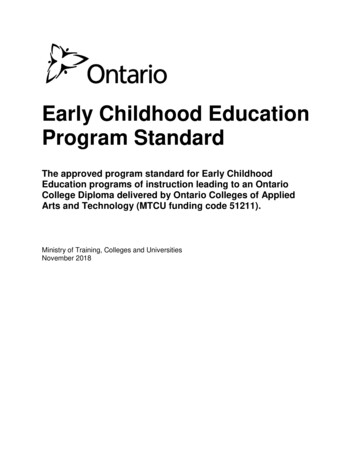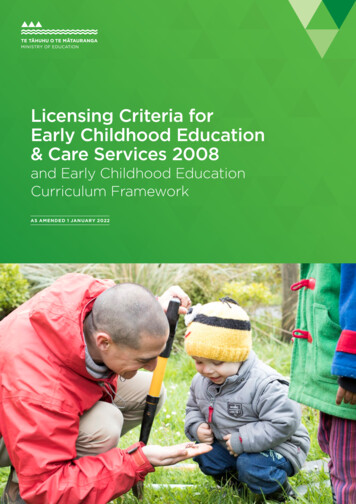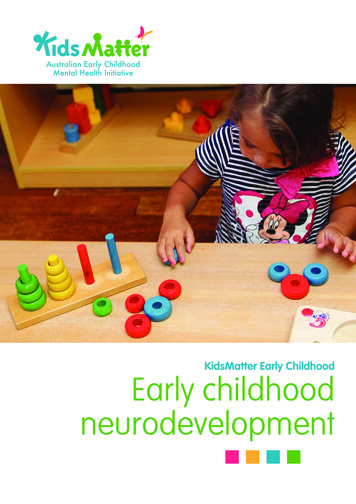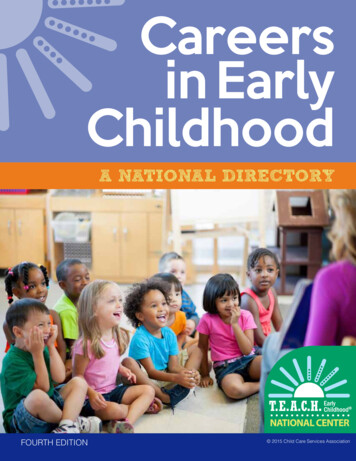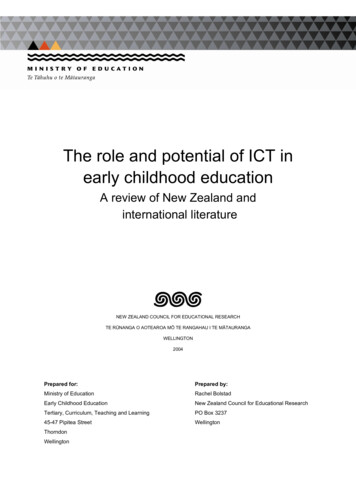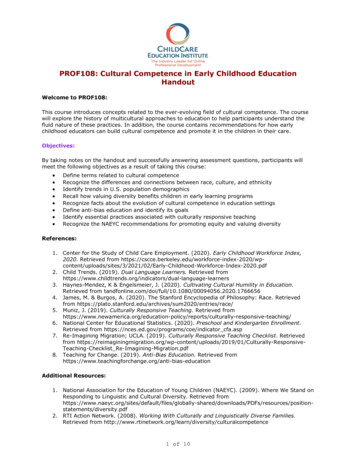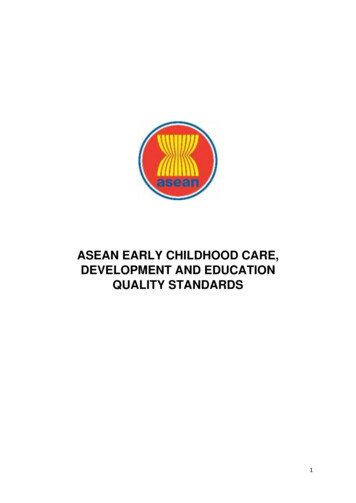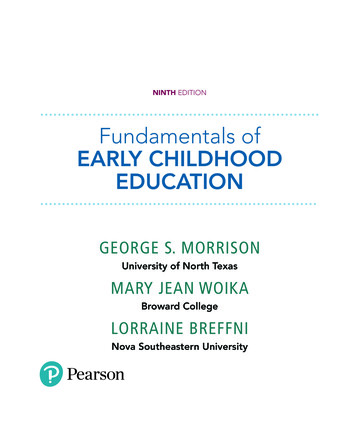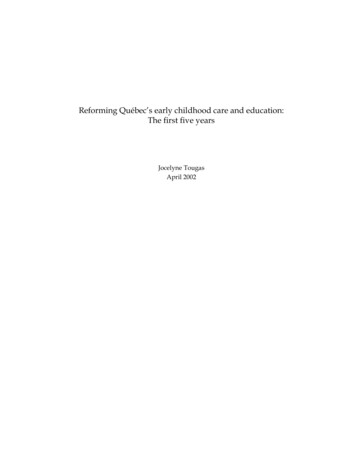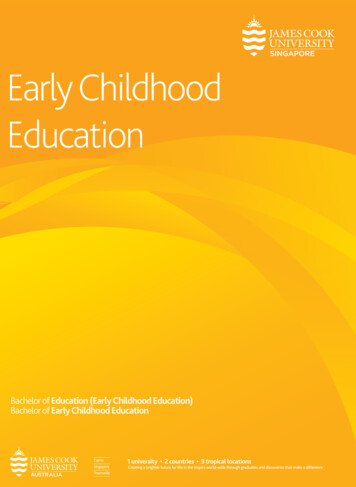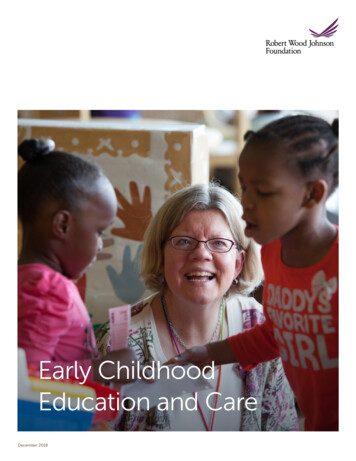
Transcription
Early ChildhoodEducation and CareDecember 2018
Early ChildhoodEducation and CareAll levels of government—federal, state, and local—as well as nonprofitorganizations, the private sector, and philanthropies play essential roles in providinghealthy, nurturing environments for our nation’s children. Federal support inparticular has expanded in recent years, thanks to growing, bipartisan backing forearly childhood programs in Congress.Federal funding for early childhood education and care promotes threeoverarching policy goals: 1) increasing children’s access to services, 2) raising thequality of early childhood programs, and 3) fostering greater coordination amongthe many providers—public schools, center-based child care, home-based childcare, Head Start, and more—of early childhood services. While many challengesremain, there are hopeful signs of progress in all three areas.In fiscal year 2018, Congress provided a historic, 2.4 billion increase for the ChildCare and Development Block Grant (CCDBG), the main source of federal fundingfor child care subsidies for low-income working families, and added another 50million in fiscal year 2019, bringing the program’s total to 5.2 billion. Estimates arenot yet available, but the new money should make it possible for significantly morefamilies to afford child care.Over the past two years, Congress has also appropriated increases for IDEAPreschool Grants, which provide special education services for preschoolers; ChildCare Access Means Parents in School, which provides campus-based child careservices for low-income parents enrolled in postsecondary education; and StudentSupport and Academic Enrichment Grants, which are highly flexible grants thatschools can use in part to support early learning.Photo: Melissa GoldenCover Photo: Melissa GoldenCopyright Robert Wood Johnson Foundation April 20171 Copyright Robert Wood Johnson Foundation December 2018
Selected Early Childhood ProgramsThis report summarizes 17 federal programs that are particularly important forearly childhood education and care.SEVEN PROGRAMS THAT ARE DEDICATEDEXCLUSIVELY TO SUPPORTING EARLYCHILDHOOD EDUCATION AND/OR CHILD CARE:Photo: Tyrone TurnerTo help raise the quality of child care services, Congressstipulated that some of the additional CCDBG fundingin fiscal year 2018 must be used to support the fullimplementation of the CCDBG Act of 2014. Among otherchanges, states are now required to conduct criminalbackground checks for all child care staff membersand to establish health and safety requirements in 10designated areas. The law also requires states to increasethe minimum amount they set aside for improving thequality of child care services, from 4 percent of theirfederal child care allocations to 9 percent, over 5 years.Improving coordination among the nation’s earlychildhood providers has become an especially highpriority in Washington. One example is Early Head StartChild Care Partnerships (EHS-CCP), which received a 50 million increase in fiscal year 2019, for a total of 805 million. The goal of EHS-CCP is to integrate thestrengths of two separate programs that serve infantsand toddlers: Early Head Start (EHS) and the ChildCare Development Fund (CCDF). EHS providers mustcomply with rigorous child development standards.Providers that serve CCDF-funded children and chooseto participate in EHS-CCP must meet those samerequirements. As a result, more children are benefitingfrom comprehensive services that they were notnecessarily receiving before, such as health screenings. Areport from the U.S. Department of Health and HumanServices (HHS) found that the partnerships also helpimprove collaborations in local communities.¹Another recent example of how Congress has prioritizedcoordination is the Preschool Development GrantBirth Through 5 (PDG B-5) program. This competitivegrant program, administered jointly by HHS and theU.S. Department of Education, will assist states incoordinating early childhood education programs thatalready exist in a mixed-delivery system. The first awardsare expected to be announced in December 2018.2 Copyright Robert Wood Johnson Foundation December 2018Despite these recent advances, the nation is nowhereclose to providing all children with high-quality earlyeducation and care.Even after the 2.4 billion increase for CCDBG in fiscalyear 2018, total federal funding for child care that year(including funding transferred into CCDBG from theTemporary Assistance for Needy Families block grant)remained nearly 1 billion below the total in fiscal year2001 after adjusting for inflation.²Only 40 percent of 3-year-olds in the United Statesare enrolled in early childhood programs, far belowthe 70 percent average of other developed economiesin the Organisation for Economic Co-operationand Development (OECD).³ Access is particularlychallenging for low-income families. Only 18 percentof children from such families are enrolled in highquality pre-kindergarten.⁴ Meanwhile, approximatelyhalf of Americans live in “child care deserts,” with littleor no access to quality child care.⁵ On average, statesprovide child care subsidies to less than 1 in 7 childrenin low-income families, and these subsidies cover only afraction of the cost of providing high-quality child care.⁶10 PROGRAMS FOR WHICH EARLY CHILDHOODEDUCATION AND/OR CHILD CARE IS ANALLOWABLE USE:– Head Start– Title I Grants to Local Education Agencies (LEAs)– Child Care and Development Fund (CCDF)– Student Support and Academic Enrichment (Title IV)Grants– Maternal, Infant, and Early Childhood Home Visiting(MIECHV)– Promise Neighborhoods– Preschool Development Grants (PDG)– Indian Education Grants to LEAs– IDEA Grants for Infants and Families– Comprehensive Literacy Development Grants– IDEA Preschool Grants– Supporting Effective Instruction (Title II) State Grants– Child Care Access Means Parents in School(CCAMPIS)– Social Services Block Grant (SSBG)– Temporary Assistance for Needy Families (TANF)– Family and Child Education (FACE)– Child and Adult Care Food Program (CACFP)This report summarizes 17 selected federal programs thatare particularly important for early childhood educationand care. They are divided into two categories:– Seven programs for which early childhood educationand/or care is the sole purpose. These programs arededicated exclusively to supporting early childhoodeducation and/or child care.– Ten programs for which early childhood educationand/or care is an allowable use. These programsare not dedicated exclusively to supporting earlychildhood education and/or child care, but significantportions of their funding are used for that purpose.3 Copyright Robert Wood Johnson Foundation December 2018
EARLY CHILDHOOD EDUCATION AND/OR CHILD CARE IS THE SOLE PURPOSEEARLY CHILDHOOD EDUCATION AND/OR CHILD CARE IS AN ALLOWABLE USEBelow are seven federal programs that are dedicated exclusively to supporting early childhoodeducation and/or child care.Numerous federal programs are not dedicated exclusively to supporting early childhood education and/or child carebut could potentially be used for those purposes. Below are 10 of the most important in this category.PROGRAMAGENCYFY18 FUNDING(ALL INMILLIONS)FY19 FUNDING(ALL INMILLIONS)PURPOSEELIGIBILITYNUMBER OFPARTICIPANTSHead StartHHS 9,863.1(discretionary) 10,063.1(discretionary)Total includes 755 for EarlyHead Start–Child CarePartnership andEarly Head StartExpansion GrantsTotal includes 805 for EarlyHead Start–Child CarePartnership andEarly Head StartExpansion GrantsPromotes school readiness forchildren in low-income familiesby offering educational, nutritional,health, social, and other services.Head Start primarily serves 3- and4-year-olds. The program alsoincludes Early Head Start (EHS),which serves pregnant women,infants, and toddlers (from birthuntil the child turns 3), and EarlyHead Start–Child Care (EHS-CC)Partnerships, in which EHS programspartner with child care providersserving infants and toddlers.Funding is awardedcompetitively to granteesin local communities. InFY17, there were 1,574grantees.⁷ In general,children are eligible if theirfamily income is below thepoverty line or if they arecategorically eligible (e.g.,receive public assistance orare homeless).899,374 “fundedenrollment slots” inFY17. Of these, 168,049were for EHS orEHS-CC Partnerships.⁸Cumulatively, HeadStart programs served1,070,000 children andpregnant women in2016-2017.Helps low-income working familiesand families engaged in training oreducation activities access child care.The CCDF consists of the Child CareDevelopment Block Grant (CCDBG)and mandatory funds authorized bythe Social Security Act and relatedmatching funds.Funding is awarded byformula to states, whichprovide subsidies to lowincome families. To beeligible, children must beunder 13 and living withparents who are workingor attending school or jobtraining.1.37 million childrenreceived assistancethrough CCDF in anaverage month in FY16;55% were ages birthto 4.⁹Supports home visiting services forpregnant women and families withyoung children (birth to kindergartenentry) who live in communitiesthat have concentrations ofpoor child health and otherrisk indicators. The visits aim tosupport parents’ involvement intheir child’s development and helpthem understand the milestonesof physical, social, and emotionalgrowth.HHS awards funding tostates through a mix offormula and competitivegrants. States must put apriority on serving familiesthat meet any of severalcriteria, such as lowincome or history of childneglect.More than 156,000parents and children inFY17.¹⁰In its new form, beginning in FY18,the Preschool Development GrantsBirth Through Five (PDG B-5)program provides competitivelyawarded funding to states to helpthem coordinate their existingearly care and learning services andfunding streams for the purposeof providing equal access to morechildren in a mixed delivery model.Funding cannot be used to createnew programs.StatesProvides formula grants to statesto help them implement statewidesystems for providing earlyintervention services for infants andtoddlers with disabilities (from birthto age 2) and their families.StatesChildCare andDevelopmentFund (CCDF)HHSMaternal,Infant, andEarly ChildhoodHome Visiting(MIECHV)HHSPreschoolDevelopmentGrants (PDG)IDEAPreschoolHHS/ED¹¹ED 8,143 8,193( 5,226 indiscretionary,through CCDBG,and 2,917 inmandatory)( 5,276 indiscretionary,through CCDBG,and 2,917 inmandatory) 400(mandatory) 400(mandatory) 250(discretionary) 470(discretionary) 250(discretionary) 470(discretionary)49,263 4-year-oldsin 18 grantee statesbenefited from theoriginal PDG program in2017.¹² Total includesnew slots and “improved”slots.AGENCYFY18 FUNDING(ALL INMILLIONS)FY19 FUNDING(ALL INMILLIONS)PURPOSEELIGIBILITYNUMBER OFPARTICIPANTSTitle I Grantsto Local EducationAgencies (LEAs)ED 15,759.8(discretionary) 15,859.8(discretionary)Provides supplementary education funding,especially in high-poverty areas, for localprograms that provide extra academicsupport to help students in high-povertyschools meet state academic standards.Districts may use some of their funds forpreschoolers if they choose. In addition, manystates are using new provisions in the EveryStudent Succeeds Act (ESSA) to leverage TitleI funds to promote early learning.Funding is awardedthrough states to LEAsand schools via fourformulas, all of whichtake family income intoaccount, along withother factors.26.4 million studentsoverall in 2015-2016school year. Ofthose, 661,016 werepreschoolers.¹⁶Student Supportand AcademicEnrichment (Title IV)GrantsED 1,100 1,170Supports activities in three broad areas:well-rounded educational opportunities,student safety and health, and effective usesof technology. Early learning is among manypossible uses of this highly flexible blockgrant.Formula grants to statesand subgrants to LEAs.State allocations arebased on each state’sshare of funds underTitle I Grants to LEAs.Not available.PromiseNeighborhoodsED 78.3(discretionary) 78.3(discretionary)Supports distressed communities inimplementing a “cradle to career” continuumof services designed to improve the academicand developmental outcomes for children,youth, and their families. High-quality earlyeducation is a required component.Nonprofit organizations,IHEs, and Indian tribes.Not available.Indian EducationGrants to LEAsED 105.4(discretionary) 105.4(discretionary)Provides assistance to elementary andsecondary schools for programs servingAmerican Indian and Alaska Native (AI/AN)students, including preschool children. Theprogram supports local efforts to address theparticular academic needs of AI/AN childrenin public schools through activities such asafterschool programs, tutoring, counseling,and dropout prevention.LEAs, schools operatedor supported by theDepartment of theInterior’s Bureau ofIndian Education (BIE),and Indian tribes ororganizations are eligiblefor grants. All must meetcertain enrollment ormembership criteria.In FY17, 463,808students were eligibleto be served through1,305 grants.¹⁷ Abreakdown by agesis not available.ComprehensiveLiteracyDevelopmentGrantsED 190(discretionary) 190(discretionary)Supports efforts to improve literacyinstruction in high-need schools or earlychildhood education programs. At least 15%of the funds must be used to serve childrenfrom birth to age 5.Competitive grantsawarded to states, whichthen award subgrants toeligible entities.Not available.Supporting EffectiveInstruction (Title II)State GrantsED 2,055.8(discretionary) 2,055.8(discretionary)Supports a wide variety of activities intendedto improve the quality and effectiveness ofteachers, principals, and other school leaders.New provisions in ESSA allow states and LEAsto use these funds to support the professionaldevelopment of early educators.Formula grants to statesand subgrants to LEAs.State allocations arebased mostly on thenumber of school-agechildren living in poverty.Not available.Social Services BlockGrant (SSBG)HHS 1,587.8*(mandatory) 1,594.6*(mandatory)States may transferup to 10% of TANFgrants to SSBGStates may transferup to 10% of TANFgrants to SSBGSupports states in helping low-incomechildren and families, people with disabilities,and the elderly achieve self-sufficiency andeconomic independence. Child day care—defined as serving infants, preschoolers, andschool-age children—is one of many possibleuses of the funding.There are no federaleligibility criteria forSSBG participants; stateshave total discretion toset their own.3.7 million childrenattended day careprograms funded bystates’ SSBG allocationsand TANF transfers intoSSBG, combined, inFY15.¹⁸ 16,739 (mandatory) 16,739 (mandatory)States mustalso contributemaintenance-ofeffort funding.Provides a highly flexible block grant to statesto help address the root causes and effects ofchildhood poverty. Among the many possibleuses of TANF, states can transfer up to 30% oftheir block grants to the CCDF and/or providechild care services directly. States can also useTANF funds for preschool.All states receive a TANFblock grant based ona formula set in 1996.States generally useTANF funds to serve poorfamilies with children,but they have widediscretion on eligibility.Not available.States mustalso contributemaintenance-ofeffort funding.377,463 children inFY17.¹³IDEA PreschoolGrantsED 381.1(discretionary) 391.1(discretionary)Provides formula grants to states forthe provision of special educationand related services to children withdisabilities ages 3 to 5.States760,000 children inFY17.¹⁴Child CareAccess MeansParentsin )Provides campus-based child careservices for low-income parentsenrolled in postsecondary education.CCAMPIS services may include carebefore and after school.Institutions of highereducation (IHEs) competefor grants. Low-incomeparents at grantee IHEswho are eligible to receivea Federal Pell grant mayparticipate.3,396 postsecondarystudents in FY16.¹⁵4 Copyright Robert Wood Johnson Foundation December 2018PROGRAMTemporaryAssistance for NeedyFamilies (TANF)HHSFamily and ChildEducation (FACE)Interior 18.8(discretionary)TBD (pendingenactmentof Interiorappropriations bill)Provides two-generation support for earlychild and family development to AmericanIndian families through home- and centerbased settings. Children ages 3 to 5 receivepreschool education.Families with children atBIE-funded schools.2,217 children in the2016-2017 schoolyear.¹⁹Child and AdultCare FoodProgram (CACFP)USDA 3,832.7(mandatory—estimate) 3,933.4(mandatory—estimate)Subsidizes meals and snacks to serve inlicensed child care centers, family and groupday care homes, afterschool programs, andHead Start centers. Most participants are ofpreschool age.Centers participating inthe CACFP must serveparticipants who meetincome guidelines basedon the federal povertyline.4.2 million children onan average day in FY17.²⁰5 Copyright Robert Wood Johnson Foundation December 2018
FEDERAL PROGRAMS THAT ARE DEDICATEDEXCLUSIVELY TO EARLY CHILDHOODEDUCATION AND/OR CHILD CAREHead StartCreated in 1965 as part of the War on Poverty, HeadStart is the largest federal investment in early childhoodeducation and development. The program promotesschool readiness of children from low-income familiesthrough education, health, social, and other services.Head Start annually serves about 1 million childrenand their families. While the program is administeredat the federal level by the U.S. Department of Healthand Human Services (HHS), Head Start is operated by anetwork of approximately 1,600 local grantees. FederalIn January 2018, HHS waived a policy that wouldhave required many Head Start centers to operatemore hours.funding flows directly to these public and privategrantees to provide comprehensive services to childrenand families. Most of the children served are 3- or 4-yearolds, but the program also includes Early Head Start (EHS),which serves pregnant women, infants, and toddlers (untilthe child turns 3). In fiscal year 2017, EHS enrollmentaccounted for almost 19 percent of total Head Startenrollment, a share that has gradually risen over time.²¹In the 2016-2017 school year, 31 percent of eligiblechildren ages 3 to 5 had access to Head Start; only about7 percent of eligible children under 3 had access to EHS.²²Congress established a set-aside within Head Startin fiscal year 2014 for Early Head Start-Child CarePartnerships (EHS-CCP). This program seeks to increasethe supply of high-quality early learning opportunitiesfor infants and toddlers and better align the continuumof care and development by setting up partnershipsbetween EHS providers with licensed child care providersthat agree to meet Head Start performance standards.6 Copyright Robert Wood Johnson Foundation December 2018In fiscal year 2017, funding specifically dedicated byCongress for Early Head Start expansion and EHSCCP allowed HHS to fund 350 grantees serving 38,527children and families.²³Recent efforts to encourage grantees to increasetheir hours of operations have come in fits and starts.Grantees are currently required to provide a minimumof 448 annual hours of classes. Research has suggested,however, that disadvantaged children may benefit fromlonger exposure to early learning programs. To that end,in September 2016, HHS issued new Head Start ProgramPerformance Standards—the first comprehensive updateto the standards since 1975—that required each HeadStart center-based program, by Aug. 1, 2019, to provide1,020 annual hours of classes for at least half of itscenter-based funded enrollment. And in fiscal year 2018,Congress set aside 260 million to support the goal ofincreasing program hours.However, in January 2018, HHS waived the newrequirement on program duration before it could takeeffect. The Department estimated that without significantadditional new funding, the requirement would resultin 41,000 fewer Head Start slots. The waiver noted:“Although research points to the benefits of increasedservice duration for an individual child, research has notanswered whether the population as a whole benefitsmore when fewer children are served for a longer timeas compared to more children being served for a shortertime.”²⁴Funding: Congress has increased funding for Head Startfor each of the past 4 years. The increase in fiscal year2019 was 200 million, for a total of 10.1 billion. Withinthat increase, 50 million was directed to Early HeadStart and EHS-CCP, for a total of 805 million.For more information, see: www.acf.hhs.gov/ohs.Photo: Lynn JohnsonChild Care and Development Fund(CCDF)The CCDF, administered by HHS, is the main source offederal funding for child care subsidies for low-incomeworking families. It includes a mix of discretionaryfunds—through the Child Care and Development BlockGrant (CCDBG), which is authorized by the CCDBGAct and funded annually through the discretionaryappropriations process—and mandatory funds(sometimes referred to as the Child Care Entitlementto States, or CCES) authorized by the Social SecurityAct and related matching funds. In addition, states havethe option of transferring a portion of their TemporaryAssistance for Needy Families (TANF) block grants intothe CCDF.The discretionary and mandatory funds are bothallocated to states by formula (though under differentcriteria), but all CCDF funds must be spent accordingto the same CCDBG Act rules. Those rules changed asa result of the act’s reauthorization in 2014. Among thenew provisions intended to protect children’s healthand safety, states are required to conduct criminalbackground checks for all child care staff members;conduct pre-licensure and annual unannouncedinspections of licensed CCDF providers and annualinspections of license-exempt CCDF providers; andestablish health and safety requirements in 10 topicareas, such as first aid and CPR. The law also requiresstates to increase the minimum amount they set asidefor improving the quality of child care services, from4 percent of their CCDF allocations to 9 percent, over5 years. In addition, states will be required to spend aminimum of 3 percent of their allocations to improve thequality of care for infants and toddlers.²⁵To be eligible for subsidies, families must have lowincomes (states have some discretion to set incomecriteria) and the children must be under 13 and livingwith parents who are working or attending school orjob training. Parents typically receive a certificate (orvoucher) that they can use to purchase services from aprovider of their choice.In fiscal year 2016, the most recent year for which dataare available, an average of 1.37 million children receivedassistance from the CCDF per month. Twenty-eightpercent of those served were infants and toddlers (underage 3); another 27 percent were ages 3 and 4.²⁶ The fiscalyear 2016 average monthly total was the lowest in theprogram’s history, according to the Center for Law andSocial Policy.²⁷ But the number may grow thanks to ahistoric, 2.4 billion increase for the CCDBG in fiscal year2018.The explanatory statement accompanying the fiscal year2018 appropriations bill said Congress expected thatthe increase “will support the full implementation of theCCDBG Act as reauthorized in 2014, including activities7 Copyright Robert Wood Johnson Foundation December 2018
to improve the quality and safety of child care programs,increasing provider reimbursement rates, and ensuringhealth and safety standards are met. The funding willalso increase access to affordable, high-quality childcare to more low-income, working families.”over the course of more than 940,000 home visits. Bycomparison, the program served about 34,000 familiesin fiscal year 2012.²⁹Funding: Discretionary funding for the CCDBG rose by 50 million in fiscal year 2019, for a total of nearly 5.3billion. Mandatory funding has remained flat at 2.917billion since fiscal year 2006.Congress established MIECHV in 2010 through theAffordable Care Act. The Bipartisan Budget Act of2018 extended MIECHV funding for five years at thecurrent funding level of 400 million per year throughfiscal year 2022. Notable policy changes in thereauthorization include a requirement for a statewideneeds assessment update by Oct. 1, 2020, a new “payfor outcomes” authority, and a requirement to developdata exchange standards for improved interoperability.For more information, see: cf master cj acf final 3 19 0.pdf (pages 79-102).Maternal, Infant, and Early ChildhoodHome Visiting (MIECHV)The MIECHV program, administered by HHS, supportspregnant women and families and helps at-riskparents of young children (from birth to the start ofkindergarten) access the resources and develop the skillsthey need to raise children who are physically, socially,and emotionally healthy and ready to learn. MIECHVfunding cannot be used for child care or early childhoodeducation, but it often serves as a gateway to theseservices. Funding is provided to states and territories,which manage and support local agencies that conducthome visits.Grantees may use any of 18 service delivery models thatmeet HHS criteria for evidence of effectiveness. Themodels vary based on family needs, but all reflect atwo-generation approach to improving the well-beingof parents and children. Research has shown that homevisiting helps prevent child abuse and neglect, improvesmaternal and child health, supports positive parentingpractices, and promotes child development, amongother benefits.²⁸Visits are carried out over an extended period and areconducted by nurses, mental health clinicians, socialworkers, or paraprofessionals with specialized training.The visits aim to support and encourage parents’involvement in their child’s development and helpthem understand the milestones of physical, social, andemotional growth. MIECHV also seeks to link families toother resources available in their area, including childcare. In fiscal year 2017, the program served more than156,000 parents and children in about 80,000 families,8 Copyright Robert Wood Johnson Foundation December 2018Funding: Annual funding for MIECHV has remained flat,at 400 million, since fiscal year 2013.For more information, see: tives/home-visitingoverview.Preschool Development Grants (PDG)The PDG program was established in the fiscal year2014 Labor, Health and Human Services, and EducationAppropriations bill, but Congress altered the programsignificantly when authorizing it within the EveryStudent Succeeds Act (ESSA). Most notably, PDG isnow housed and funded at HHS rather than at the U.S.Department of Education (ED), its previous home. EDand HHS are continuing to administer the programjointly, but HHS now has the lead. The purpose of theoriginal program was to build state and local capacityto provide preschool for 4-year-olds from low- andmoderate-income families. In conjunction with HHS,the Department of Education awarded competitivegrants to 18 states; five received development grantsand 13 received expansion grants. fiscal year 2017 wasthe fourth and final year of these grants.The Every Student Succeeds Act gives HHS thelead in overseeing Preschool Development Grants.Photo: Lynn JohnsonA recent progress report on the legacy PDG programfound that nearly 26,000 new preschool slots werecreated. Nearly 23,000 other slots were “improved”through a variety of quality initiatives.³⁰The new iteration of the program, PreschoolDevelopment Grant Birth Through 5 (PDG B-5), putsa higher priority on maximizing parental choice andcoordinating early childhood education (ECE) programsthat already exist in a mixed delivery system. Fundingfrom PDG B-5 may not be used to create new early careand learning programs. “In summary,” the September2018 grant announcement states, “the PDG B-5 grantswill support States in their efforts to analyze the currentlandscape of their ECE mixed delivery system andimplement changes to the system that maximize theavailability of high-quality early childhood care andeducation options for low-income and disadvantagedfamilies across providers and partners, improve thequality of care, streamline administrative infrastructure,and improve State-level early childhood care andeducation funding efficiencies.”³¹ ESSA also adds newprohibitions on the federal government’s ability toinfluence state programs; for example, the federalgovernment will no longer be allowed to define “highquality” as it relates to early learning.HHS expects to award 40 PDG B-5 grants using fiscalyear 2018 funding.Funding: PDG funding has remained flat since fiscal year2014 at 250 million.For more information, see: ative.9 Copyright Robert Wood Johnson Foundation December 2018
FEDERAL PROGRAMS FOR WHICH EARLYCHILDHOOD EDUCATION AND/OR CHILDCARE IS AN ALLOWABLE USETitle I Grants to Local EducationalAgencies (LEA)sPhoto: Lynn JohnsonIDEA Preschool Grants (Part B, Sec. 619)The IDEA Preschool Grants program provides formulagrants to states to support special education servicesfor children with disabilities aged 3 through 5. To receivethese grants, states must make a free appropriate publiceducation available to all 3- through 5-year-olds withdisabilities; in recent years, all states have satisfied thisrequirement. States distribute most of their awardsto local education agencies (LEAs), which generallycombine their Sec. 619 (Preschool Grants) funding withother IDEA funding they receive through Sec. 611 (Grantsto States for Education of Children with Disabilities) tohelp meet the excess costs of educating preschool-agedchildren with disabilities.Funding: Congress provided a 10 million increase forthis program in fiscal year 2019, for a total of 391.1million, barely surpassing the fiscal year 2002 level of 390 million.For more information, see: A Grants for
dedicated exclusively to supporting early childhood education and/or child care. - Ten programs for which early childhood education and/or care is an allowable use. These programs are not dedicated exclusively to supporting early childhood education and/or child care, but significant portions of their funding are used for that purpose.
